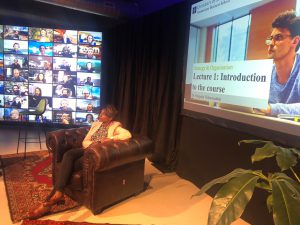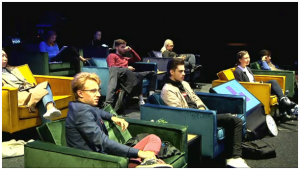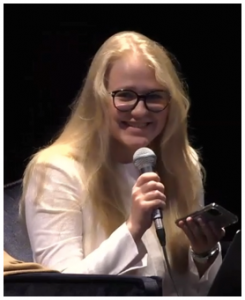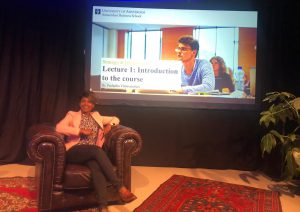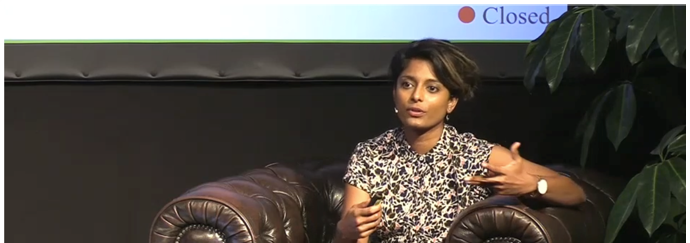
Teacher Story: Pushpika Vishwanathan
Interview with Dr. Pushpika Vishwanathan
Faculty of Econonomics and Business (FEB)
The Hybrid Learning Theatre: Live lectures with a Zoom wall
This academic year (2020-2021), lectures for 1500 first-year students of Economic and Business in theatres like Carré and De la Mar are simply not possible due to Covid-19. In order to offer a learning experience with active participation and interaction, UvA Economics and Business opened the doors of the new professional ‘Hybrid Learning Theatre’ in the M (REC) building last September. Lecturer Dr. Pushpika Vishwanathan explains how this special theatre came about and gives her tips and tricks for hybrid live lectures.
The birth of the ‘Hybrid Learning Theatre’
Dr. Pushpika Vishwanathan is one of the initiators of the ‘Hybrid Learning Theatre’, together with Maarten Pieter Schinkel and programme coordinator Maud Pols. During the first lockdown period last academic year, Vishwanathan took an online course at Yale University through Coursera. The lecturer of this course gave her lecture from a sofa in a living room setting with a small live audience of 10 students. The rest of the students, including Vishwanathan, attended the lecture online. This created such a pleasant, natural atmosphere, as if she was present in an actual live class, that it gave her the idea to also teach in a similar setting. Her colleague Maarten Pieter Schinkel was charmed by a large Zoom wall on which the faces of the Zoom participants were projected, seen in Dutch television show De Wereld Draait Door.
When Schinkel and Vishwanathan brainstormed in June about what to do with the large group of first-year students in the Corona situation, they exchanged their ideas and presented them to programme coordinator Maud Pols. Pols responded with enthusiasm and in a few brainstorm sessions the hybrid theatre/lecture hall idea took shape. After technical confirmation by Education Services’ Bob Bom, the room could be built.
The theatre atmosphere of the large-scale first-year lectures in Carré and De la Mar was combined with the homelike setting of the online Yale course and the Zoom wall from the television show. In two weeks’ time, a boring exam room with neon light was transformed by a professional team from Faber company into the professional, yet homely ‘Hybrid Learning Theatre’ complete with Zoom wall, intimate theatre lighting, black velvet curtains, plants, second-hand carpets, armchairs, coffee tables three cameras with crew. “It is so special how we managed to realize this room together in a very short time, mainly via email, through enthusiasm, clear communication and the UvA in-house technical expertise. It was great fun to help make decisions ranging from where the Zoom wall should go to choosing the second-hand armchairs and carpets. Maud Pols picked up the latter herself with a cargo bike and transported them to the theatre. Maud in particular has literally and figuratively pulled the cart.”
Live students, panellists and attendees
In June Vishwanathan only taught via Zoom, but in September she could teach onsite again in their own new creation. “Teaching through Zoom hardly felt like teaching. Now that I see live students in front of me again, I can actually talk to them. It feels so luxurious to teach in a studio with three cameramen and beautiful lighting. I don’t have to be involved with technology and can focus on the lecture. I know that we are delivering something really great for 600 students and that makes it fun for them to participate.
I think I have found a smart setup for my hybrid lectures. 12 Students are allowed to be physically present, 50 students actively participate as panelists on the Zoom wall, and the remaining 300-600 students consume the lecture as attendees. They can only communicate through chat. Everyone can sign up weekly with my student assistant for one of the two active groups and she arranges the rotation. We constantly encourage students to sign up for it and I always say: if you turn on your camera, it is more likely that we will pick you. It’s not all that easy to get students to turn on their cameras. Some students really want to participate: ‘Oh please can you make me a panelist?’ There is a group of regular customers who are big fans and really enjoy coming back as a panelist or live in the room. You really work with the crème de la crème in terms of motivation and active participation. If there are few female students in the room or in the panel, I jokingly urge them: ‘Come on, where are all the ladies?’ And that works, because the following week you see that more girls have registered. I make sure that I alternate my interaction between the panel and the live attendees and I am constantly watching whether hands are raised for questions or comments. This setting allows me to focus on the people who actively participate and that creates a very nice dynamic.”
Flipped classroom, feedback-lecture and co-creation: ask a lot of questions
“On Mondays, students can watch last year’s lectures, recorded amongst other places in De La Mar Theatre. I have edited them into knowledge clips and added quizzes. On Friday I give feedback lectures at the ‘Hybrid Learning Theatre’ on questions about Monday’s lecture selected by my wonderful student assistant from the discussion board in Canvas. We reflect on the materials and go into depth. If there are any on-the-spot questions, I will deal with them. I always check comprehension with the students and ask a lot of questions anyway to actively involve them. I encourage students to answer the questions themselves as much as possible. This way we have a conversation instead of me giving a monologue. I also present a quiz consisting of about 10 multiple-choice questions that they answer by voting via Sendsteps. This means I can also actively involve that large group of attendees. This year the turn-out is higher than at the live lectures last year, but of course you never know whether an attendee is actively attending the lecture.”
“At times I feel a bit like an Oprah Winfrey”
“The live students and panel students are present half an hour before the lecture starts. I chat with them to create a relaxed, friendly atmosphere and learn their names. Addressing them by name as much as possible adds to the atmosphere. I asked the cameramen to Zoom in on the person speaking, thus creating even more involvement. It’s nice for students to see themselves. You notice that some also pay more attention to what they wear, a nice jacket or something presentable.
Just like in a talk show on tv, really. I also feel a bit like an Oprah Winfrey at times. This studio setup is great fun to work in, and will continue to be fun after Corona, when it will be possible to have more live attendees. I learn a lot from this way of working in terms of teaching in a coaching, reflection and participation, involving everyone as much as possible, but also working with cameras. I think this way of teaching is the future.” When you watch a lecture by Pushpika Vishwanathan, it does indeed look like you are watching an academic talk show. As an accomplished talk show host, she skillfully talks through the lecture by asking lots of questions and summarizing answers, dividing her attention cleverly between the live and Zoom-wall attendees. She counteracts technical problems with a joke and a smile.
Interview by Rebecca Lobry
If you are curious about the Hybrid Learning Theatre, check out the links below.
Seeing Pushpika Vishwanathan in action in the ‘Hybrid Learning Theatre’ is possible via UvA webcolleges.
Webinar with PowerPoint presentation about hybrid teaching for Surf communities, featuring Pushpika Vishwanathan from 35.36m to 48.15m.
The Hybrid Learning Theatre on Dutch tv, via NH Media.
For more information on the ‘Hybrid Learning Theatre’ please contact: hybridlearningtheatre-eb@uva.nl






